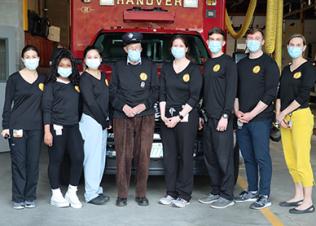Our Dermatology Residency Program trains residents to become superb medical and consultant dermatologists. The program was founded in 1948 and has a proud history of training residents to be competitive in all areas of dermatology upon graduation. Our program has a reputation for producing excellent clinical dermatologists who go on to provide excellent, state-of-the-art care to their communities. We have attracted applicants from medicals schools that have told us that their mentors recommended us as “a strong clinical training program”. Historically, about half of our residents have gone on to achieve highly competitive fellowships in laser surgery, Mohs surgery, dermatopathology, cutaneous oncology, and pediatric dermatology, and several have assumed roles in highly regarded academic programs.
About the program
The program is small, with 4 residents per year and a total of 12 residents in the 3-year program. The small size of our program and rural location typically results in a close relationship amongst residents and between residents and faculty. There has and continues to be a tutorial, mentoring element that is strong and an asset of the program.
The program director is Natalie Fragoso, MD. The program coordinator is Kelly Prouty, C-TAGME. The department chair is Michael Shane Chapman, MD. Matthew LeBoeuf, MD, is a board-certified Mohs surgeon and director of the surgical/procedural training in the program.
Training includes experience in our specialty clinics in contact dermatology/patch testing, cutaneous T-cell lymphoma (CTCL), pediatric dermatology, cosmetic dermatology, high risk skin cancer and rheumatology/dermatology. A full list of our dermatology faculty is listed on the faculty page. Adjunct faculty in specialty areas who work with our faculty and residents in specialty clinics include: Lin Brown, MD (rheumatologist, dermatology/rheumatology clinic) and Frederick Lansigan, MD (oncologist, cutaneous lymphomas clinic). The program enjoys a very good relationship with an excellent dermatopathology teaching faculty.
The primary location for training is at Dartmouth Hitchcock Clinics Heater Road. The dermatology department moved to this new location mid-November 2012. This is the home base of the program, where most clinics and conferences take place. Inpatient consults, cutaneous lymphoma clinic and tumor board, melanoma tumor board, and dermatopathogy take place at the Dartmouth Hitchcock Medical Center main campus. Dartmouth Hitchcock Medical Center is a 396-inpatient bed tertiary care hospital that runs at or near capacity every day of the year. It serves as a major tertiary-care referral site for northern New England.
Dartmouth Hitchcock Medical Center provides care to a population base of 1.5 million people covering an area that reaches from New Hampshire and Vermont to Maine, Massachusetts and New York.
